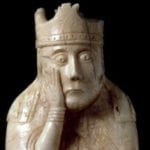 Miscellaneous
Miscellaneous  Miscellaneous
Miscellaneous  Humans
Humans 10 Ideas That Scare People to Death
 Music
Music The Cursed Decade: 10 Classic Rock Stars Who Had Low Periods in the 1980s
 Health
Health 10 Crazy Ways Sleep Deprivation Can Affect You
 History
History 10 Enthralling Facts about the Field of Cloth of Gold
 Pop Culture
Pop Culture The Ten Greatest Engineers in Science Fiction History
 Humans
Humans Ten Journalists Who Got Caught Faking the News
 Travel
Travel 10 Best Hiking Trails in America with Breathtaking Views
 Weird Stuff
Weird Stuff The 10 Weirdest Materials That Can Be Used to Make Paper
 Crime
Crime The 10 Most Infamous Gangs in History
 Miscellaneous
Miscellaneous Ten More Extremely Unexpected U.S. State “Firsts”
 Humans
Humans 10 Ideas That Scare People to Death
 Music
Music The Cursed Decade: 10 Classic Rock Stars Who Had Low Periods in the 1980s
Who's Behind Listverse?

Jamie Frater
Head Editor
Jamie founded Listverse due to an insatiable desire to share fascinating, obscure, and bizarre facts. He has been a guest speaker on numerous national radio and television stations and is a five time published author.
More About Us Health
Health 10 Crazy Ways Sleep Deprivation Can Affect You
 History
History 10 Enthralling Facts about the Field of Cloth of Gold
 Pop Culture
Pop Culture The Ten Greatest Engineers in Science Fiction History
 Humans
Humans Ten Journalists Who Got Caught Faking the News
 Travel
Travel 10 Best Hiking Trails in America with Breathtaking Views
 Weird Stuff
Weird Stuff The 10 Weirdest Materials That Can Be Used to Make Paper
 Crime
Crime The 10 Most Infamous Gangs in History
10 Craziest Events In The History Of Chess
Chess is the greatest war game ever invented. There are only 64 squares and 32 pieces, but the game’s complexity boggles the imagination. The mathematician Claude Shannon, the “Father of Information Theory,” once calculated the number of unique games that could be played. The answer was a jaw-dropping 10120, which is more than the number of atoms in the known universe (1081).
Considering the staggering possibilities inherent in the game, some believe playing chess could possibly lead to insanity. However, there is no proof that chess drives it devotees mad. Perhaps mad people gravitate toward chess because it helps keep them sane.
10 The Sugar Bomb

Chess masters are known to employ strange methods to win their games. Ruy Lopez, the famous 16th-century Spanish priest and chess player, once advised, “Sit your opponent with the sun in his eyes.” Another player named Lucena once recommended, “Try to play after your opponent has eaten or drunk freely.”
In the 19th century, Harry Nelson Pillsbury attributed his clear thinking to puffing on a cigar during his games. On the other hand, Szymon Winawer said he deliberately smoked bad cigars so the odor would mess with his opponent’s concentration. And at the 1935 World Championship, the superstitious Alexander Alekhine would place his Siamese cat on the chessboard before a game as a good luck charm. Alekhine was also allegedly hoping for an allergic reaction from his opponent. When he was forbidden to play with the cat on his lap, Alekhine turned to wearing a sweater with a picture of his pet on it.
So we are left wondering what Rosendo Balinas was trying to pull off at the 1979 Lone Pine tournament. A Filipino grand master, Balinas was playing against Jeremy Silman. The game started off quietly enough, but 10 turns later, things got a little bit crazy. According to Silman’s eyewitness account:
At this point, Balinas placed a thermos filled with hot tea on the table. Then he put a big cup of honey next to it. I expected him to take a bit of honey and mix it in with the tea, but instead he shocked me! He took the tea, poured it into the honey (which turned into a thick goo), and then drank every bit of it. Appalled, I noticed that his eyes immediately glazed over as the sugar hit his brain. Then, smiling, he continued the game.
But the Filipino was in a stupor after that incomprehensible act of self-sabotage. He lasted only another 12 moves. Silman was so sorry for him that he took no pleasure in his easy win.
9 The Weirdest World Championship
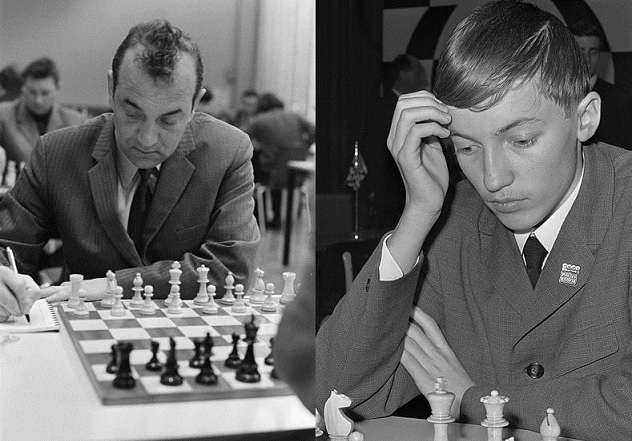
Chess is above all a mind game, and players sometimes go to ridiculous lengths to psych out their opponents. But for sheer insanity, the World Championship showdown between Viktor Korchnoi (pictured left) and Anatoly Karpov (pictured right) takes the cake.
The two grand masters were intense rivals. Karpov was a member of the Communist Party and a model of the “Soviet New Man.” Like every chess player who brought honors to the Soviet state, Karpov was rewarded with a Mercedes, a chauffeur, a Moscow apartment, and a country dacha. Korchnoi, on the other hand, was a rebel who defected to the Netherlands in 1976 and constantly criticized the Soviet system. To the Soviets, the Jewish Korchnoi was a diseased and immoral character.
The 1972 title match between Bobby Fischer and Boris Spassky proved that the Cold War could be fought as intensely on a chessboard as on an actual battlefield. In 1978, Fischer had forfeited his title, and the free world was now represented by Korchnoi. His showdown with Karpov, the ice-cold calculator from behind the Iron Curtain, took place in Baguio, Philippines.
For their first game, Korchnoi wore mirrored sunglasses to hide his eyes from Karpov’s stare, which had bothered him in a previous match. Karpov complained that the mirrors reflected the light into his eyes. Karpov also requested that Korchnoi’s chair be examined for “prohibited devices” (presumably the mind-zapping kind) and distracted his opponent by swiveling in his own chair during games.
Korchnoi’s camp then objected to the yogurt delivered to Karpov during games, suggesting that the color might be some sort of coded message. Perhaps a strawberry yogurt signified one move and raspberry another. Korchnoi was also bothered by a member of the Soviet entourage named Vladimir Zukhar, a parapsychologist who would sit in the front row and stare malevolently at him. Korchnoi suspected that Zukhar was hypnotizing him and interfering with his brain waves. Thanks to the “psychic,” Korchnoi was a nervous wreck by the seventh game.
To counteract Zukhar, Korchnoi brought in Dada and Didi, two members of an Indian sect called Ananda Marga. Zukhar had the two mystics teach him yoga and transcendental meditation. It was now the Soviet delegation’s turn to be unsettled when Dada and Didi hovered around them during the games.
Revived, Korchnoi came back from being three games behind to leveling the score at five to five. Whoever won the next game would become the champion. There was an unsubstantiated claim that the KGB was ready to poison Korchnoi. If true, his life was probably spared when he lost the tiebreaker. After failing to beat Karpov in their grudge match, Korchnoi said he would bring along the CIA next time around. Moscow simply laughed him off.
8 Chess And Espionage
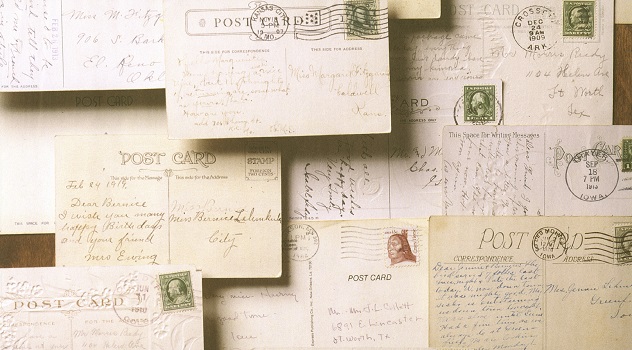
It is not strange that the KGB would be so involved in chess. The game lends itself perfectly to cloak-and-dagger operations. And since the USSR was a chess-crazy country, disguising communications as chess moves was an ideal cover. The KGB actually had a section on chess in its handbooks. In the ’60s and ’70s, the Soviet embassy in Washington kept a chess expert on staff who was also a KGB agent. According to defector Lev Alburt, many of his fellow Soviet grand masters were “KGB infiltrators.”
In 2009, a number of postcards surfaced, all addressed to Graham Mitchell. Mitchell was a deputy director general of the British MI5 during the 1950s. As for the cryptic notes, they all discussed chess games, and experts suspect they were some kind of code. The postcards are thought to have been sent by an undercover agent from Frankfurt, a hub of espionage activity during the Cold War. They contain chess notations to describe various moves. However, they’re probably ciphers with secret information. Hidden messages could also have been couched within the suspicious-sounding text. For example, the agent writes:
Without against Dr Balogh I always have now hard fights in my games.
Against Collins I have been fallen into a variation of the Nimzowich-defense who surely should be lost!
I shall try to find a new idea for defending. But only a little hope. But all my games go forward in a quick way.
Have I sent to you any games from me? And what happened in your games?
9. . . 5435 10. 1432 12.-16./6. 16./6. = od
It is not known if the agent was working for MI5, as Mitchell was suspected of being a Soviet spy at the time. As head of counterespionage, Mitchell could have been recruiting double agents for the KGB. No evidence of treason was ever found, however, and Mitchell retired in 1963.
The close affinity between chess and code breaking also led Alastair Denniston, directory of Bletchley Park, to recruit chess players to decode the German Enigma machine during World War II. Chess masters Harry Golombek, Hugh Alexander, and Sir Philip Stuart Milner-Berry immediately withdrew from the 1939 Chess Olympiad to report to Bletchley Park. The most prominent member of the code breaking team, mathematician Alan Turing, later created a chess program . . . years before the necessary computers to run such a program even existed.
7 The Chess Prodigy Who Renounced Chess
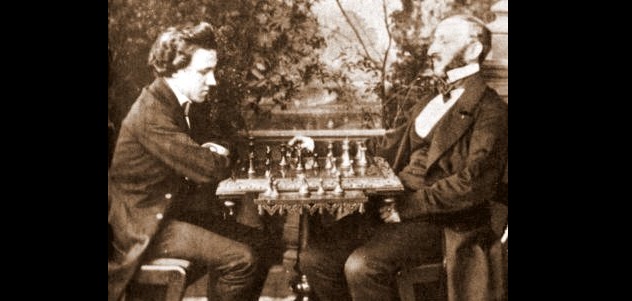
In recent years, chess has become a pretty high-stakes game, politically, ideologically, and monetarily. However, that hasn’t always been the case. In fact, the first unofficial world champion would be appalled by the giant prizes dangled in front of modern competitors. Paul Morphy (pictured left) abhorred the taint of professionalism, once writing to a rival, “Permit me to repeat that I am not a professional player; that I never wished to make any skill I possess the means of pecuniary advancement, and that my earnest wish is never to play for any sake but honor.”
However, Morphy’s superhuman powers on the chessboard astounded his contemporaries. Born in New Orleans in 1837, Paul was a child prodigy who was beating his father and uncle by age 10. He’d never consulted a chess book, yet he was handling the pieces with an intuitively precise grasp of strategy and tactics. At age 13, he shocked the chess world by defeating the Hungarian master Johann Lowenthal (pictured right). It then became Morphy’s great ambition to defeat the best masters in the US and Europe.
After earning his law degree in 1857, Morphy set out on his insane quest. Howard Staunton, Britain’s star player, avoided him and was accused of cowardice. In Paris, Morphy played eight opponents simultaneously, neither eating nor drinking for 10 hours until all succumbed to his brilliance. Oh, and did we mention that he was blindfolded? (The moves were called out so he could visualize them.)
But in his tours of European chess circles, the idealistic Morphy was disgusted at how the game was being made into a business. While Morphy loved chess itself, he was repelled by this practice. He was further alienated from the game when he saw how it took him away from more important things, particularly his law career. However, people were more interested in Morphy the chess player than Morphy the lawyer, and his practiced folded after a few months. Adding insult to injury, a girl he was courting rejected the idea of marrying a “mere chess player.”
Frustrated, Morphy simply gave up on the game. He was reluctant to even play privately, and he never again dazzled the world with his power. Many tried to cajole him out of his aversion to the game. Once, a financially desperate Morphy approached an old friend to borrow $200. The friend said he would make it $250 if Morphy played a game with him. Grudgingly, Morphy agreed, but he showed his distaste by deliberately losing. Afterward, he left without bothering to collect his money.
On another occasion, Morphy was informed that the self-proclaimed world champion, Wilhelm Steinitz, was in New Orleans and wanted to see him. Morphy reluctantly agreed to a meeting on the condition that chess must not even be alluded to. After an embarrassing 10 minutes with nothing to discuss, Morphy and Steinitz parted ways.
In his later life, Morphy began showing signs of insanity. He suspected his brother-in-law of trying to poison him and refused to eat unless the food was prepared by his mother or sister. Morphy believed barbers were planning to slit his throat. He haunted Canal Street in New Orleans, muttering and smiling to himself, all while swinging his cane at anyone who approached him. He also stalked attractive women around town for hours.
Morphy’s relatives tried to commit him to an asylum, but he defended his sanity with clever expositions on his civil liberties, thus convincing officials to let him go. Sadly, Paul Morphy, the “Pride and Sorrow of Chess,” died in his home on July 10, 1884.
6 The World Champion Who Defeated God
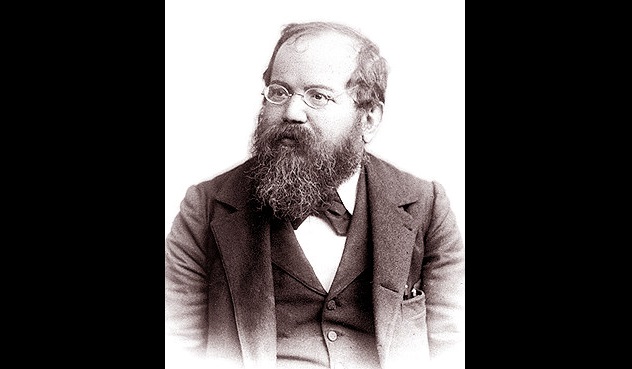
Wilhelm Steinitz forever changed the way chess is played with his revolutionary theories, thus earning him the title of the “Father of Modern Chess.” Steinitz did away with the Romantic era of chess—a period when unsound attacks and flashy sacrifices were the norm—and substituted a more scientific and analytical way of playing.
Steinitz was born in Prague in 1836 to Jewish parents. Unlike Paul Morphy, he wasn’t loath to earn a living from chess. He defeated the world’s best player, Adolf Anderssen, in 1866 and proclaimed himself world champion. But his egotism and bad temper earned him few fans. Nevertheless, he defended his title ably. Steinitz played his match against Mikhail Tchigorin of Russia via cable. Steinitz was in New York, and Tchigorin was in Havana. New York police arrested Steinitz as a spy because they misinterpreted his chess moves as spy-talk.
The use of technology to play long-distance chess took a weird turn when Steinitz supposedly claimed that he used a telephone to call God and beat Him at chess, even after giving Him an extra pawn. This was an age when electricity was largely a mystery. The telephone was still in its infancy. It was also the heyday of spiritualism, and it was speculated that electricity might have something to do with the equally mysterious realm of the supernatural. If God, angels, and spirits were electrical entities as some supposed, then perhaps it was possible to communicate with them by electrical means.
The story of Steinitz defeating God is likely a garbled conflation of two separate incidents. In the first, Steinitz contemplated the possibility of telephoning or telegraphing God. In the second, he speculated on his results should he challenge God at chess. Taken in that context, it’s hard to interpret the story as a sign of Steinitz’s madness, as some historians have.
Still, there’s no doubt that Steinitz had mental issues. Whether they were caused by chess or some other factor is a matter of dispute. Either way, in 1899, his condition grew worse after failing in a London tournament. Steinitz had to be shut up inside a sanatorium. Tragically, the chess champion passed away on August 12, 1900, poor and insane.
5 The Jew Who Dined With Nazis
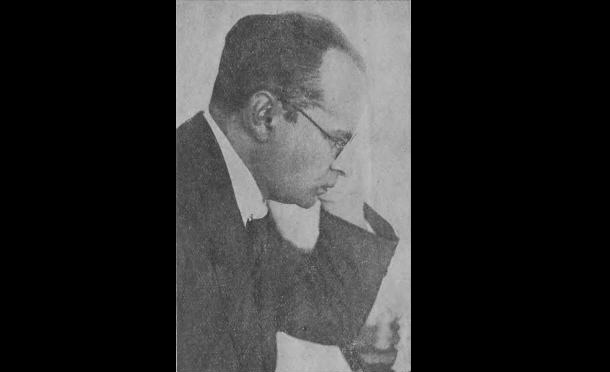
Aron Nimzowitsch rescued chess from the rigidity of doctrine that followed Steinitz’s reformation. Nimzowitsch taught the chess world new strategic principles and more creative ways of approaching the game. His theories were ridiculed and mocked at first, but the new vitality they brought to the board was adopted by more and more players. Today, Nimzowitsch’s hypermodern style has been vindicated.
Nimzowitsch was born in 1886 in Riga, Latvia. His father, a Hasidic Jew, was a chess player of master strength. As a child, Aron occupied himself with the study of the Talmud. But after learning chess at age eight, he began to play seriously. By the early 20th century, Nimzowitsch was among the chess heavyweights. He became a Danish citizen in 1922.
Like many players, Nimzowitsch had a peculiar streak. His most famous tantrum came when he jumped on a table after a loss and shouted, “Why must I lose to this idiot?” As his friend Hans Kmoch recalled:
Nimzowitsch suffered from the delusion that he was unappreciated and that the reason was malice. His paranoia was most evident when he dined in company. He always thought he was served much smaller portions than everyone else. He didn’t care about the actual amount but only about the imagined affront. I once suggested that he and I order what the other actually wanted and, when the food was served, exchange plates. After we had done so, he shook his head in disbelief, still thinking that he had received the smaller portion.
In one tournament in Bled, Yugoslavia, Nimzowitsch showed up at the playing hall in only a bathrobe. As the queen of Yugoslavia was due any moment, Kmoch took his friend by the neck and kicked him out the door. Then there was the time that a doctor told Nimzowitsch to exercise more often, so he complied by doing calisthenics during games. According to grand master Reuben Fine, he actually stood on his head as he waited for his turn to move.
With Hitler’s rise to power in the 1930s, Europe became a much more dangerous place for Jews like Nimzowitsch. However, Nimzowitsch was confident because he was protected by three consulates: the Latvian, the Danish, and the Dutch (he worked for a newspaper in the Netherlands). He boasted of this protection to Reich Minister Hans Frank. This was the same Hans Frank who would later mass murder Jews in Poland, so Nimzowitsch was flirting with disaster.
In 1934, Germany hosted the Alekhine-Bogoljubov world championship match, and Nimzowitsch followed the games as a reporter. One day, a high-ranking Nazi official entered the press room. Nimzowitsch demanded his credentials and when the Nazi failed to show them, the reporter ordered him out. The shocked onlookers fully expected the Nazi to fall on the Jew who dared boss him around. But the German simply left. Hans Frank also watched the games and invited the group to his villa for lunch. At the table, Nimzowitsch’s paranoia surfaced again, and he began complaining that his plate and knife were dirty. Opposite him, the future “Butcher of Poland” pretended not to hear.
Nimzowitsch was lucky his boorishness didn’t get him killed. He died of pneumonia in 1935. The entire Nimzowitsch family, save for an older sister, was wiped out during the Holocaust.
4 Simultaneous And Blindfolded
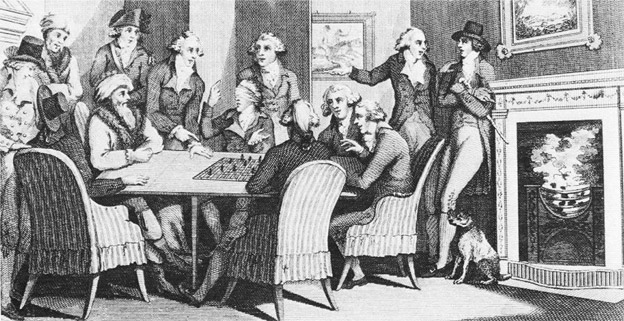
Playing chess without sight is an amazing feat of memory. Doing it simultaneously against more than one opponent makes it even more awesome. It was once considered so miraculous that in the Middle Ages, one observer thought that a blindfolded player was in league with the Devil. When Francois-Andre Philidor (pictured above) defeated two opponents in a blindfold game in the 18th century, eyewitnesses were asked to sign affidavits confirming it really happened.
Most masters can normally visualize positions in their heads. The Cuban champion Jose Raul Capablanca even found it unnecessary to own a chess set at home. If he had to set up a position physically, he used everyday household items, such as two lumps of sugar to stand in for rooks.
Blindfold chess is physically and mentally exhausting. From the very beginning, people have warned that these stunts could damage the brain. For example, a New York Sun obituary for Paul Morphy said, “The strain in his brain produced a brain fever, from which he never recovered.” And The Philadelphia Evening Bulletin said Wilhelm Steinitz had “been driven insane by the game to the mastery of which he had devoted his life.”
In 1930, the USSR banned blindfold chess because of its supposed health hazards, and a Russian player allegedly died attempting to break the world record for number of opponents. World champion Mikhail Botvinnik warned against undertaking such a stunt, and his student Garry Kasparov declines to attempt it seriously.
This perceived danger did not stop some masters from pushing the envelope, and their number of opponents steadily increased over the years. Pillsbury took on 20, and Richard Reti played against 29. Alekhine challenged 32, and George Koltanowski went up against 34.
When the war broke out in Europe, many players found themselves stranded in Argentina after the 1939 Olympiad. The Jewish players particularly felt that to return home would be foolhardy. With no way of communicating with his family in Poland, Mojsze Najdorf hit on a novel idea. He would attempt to set the world record in a simultaneous blindfold exhibition. It wasn’t a stunt for its own sake. Najdorf hoped this feat would be reported in Europe so his family might read it, know that he was safe, and contact him.
Najdorf took on 40 opponents, winning an astonishing 36 games, drawing one, and losing only three. Tragically, he never heard from his family. When Najdorf returned to Poland after the war, he discovered that they had all perished. With nothing to live for in his native land, Najdorf returned to Argentina, settled there, and changed his name to Miguel. Happily, he lived to a ripe old age, all the while lucid and perfectly sane.
3 Fischer And The False Prophet
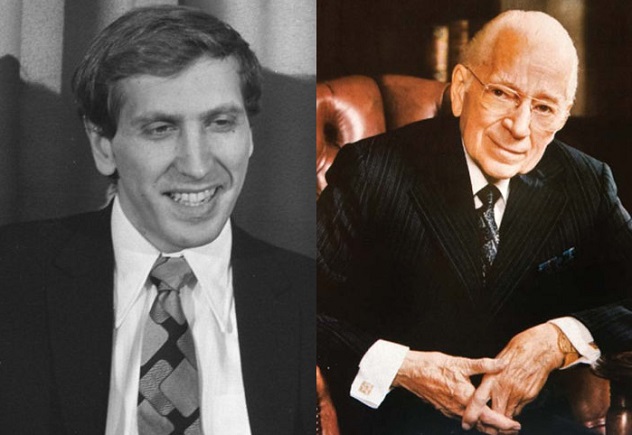
No discussion on chess insanity would be complete without mention of Bobby Fischer (pictured left), the legend who descended into paranoia and darkness in his later years. His single-handed demolition of the Soviet chess colossus has recently been made into the movie Pawn Sacrifice, starring Tobey Maguire.
To many, Fischer’s obsession with chess was his undoing. The man once said, “All I want to do, ever, is just play chess.” In fact, his preoccupation worried his mother so much that she took him to psychiatrists. Legend has it that when Fischer lost his virginity at age 19, he remarked on the experience, “Chess is better.”
But Fischer was actually interested in one other thing—religion. In the mid-1960s, he got involved with a sect (many label it a cult) called the Worldwide Church of God (WCG). It was led by a huckster named Herbert W. Armstrong (pictured right) who based his radio ministry on end-time prophecies. The cornerstone of Armstrong’s bizarre apocalyptic scenario was that the US and Britain had actually descended from the Ten Lost Tribes of Israel. He taught that God would punish America and Britain via an invasion from a United States of Europe led by Germany. Normally rational and logical, Fischer bought all of this, hook, line, and sinker.
Fischer was driven nuts trying to keep all the cult’s teachings like Sabbath observance, dietary laws, and tithing. He was also forbidden from befriending “unconverted” people. He would force himself into Bible study and prayer, even after returning exhausted from the chess club at four in the morning. Fischer also began giving his hard-earned money to the cult. Upon winning the World Championship in 1972, he sent $61,200 of his prize money to the WCG.
Meanwhile, he never improved his own standard of living nor his mother’s, a woman who lived in a shabby apartment with no bathroom. By contrast, Armstrong was living a lavish lifestyle, touring the world in his private jet, and giving expensive gifts to world leaders.
Armstrong had been predicting an imminent Great Tribulation since the 1930s and had been proven wrong repeatedly. He was now prophesying 1972 as the apocalyptic year, but when the year passed, Fischer began to see Armstrong for what he was . . . a false prophet and master manipulator. He also learned of the sexual escapades of Herbert’s son, Garner Ted, and concluded they were both hypocrites. Fischer left the WCG. He could only lament in the end, “And I should have known that it was all just a pack of lies. He was just playing with me. Lie after lie . . . ”
2 Chess Rage
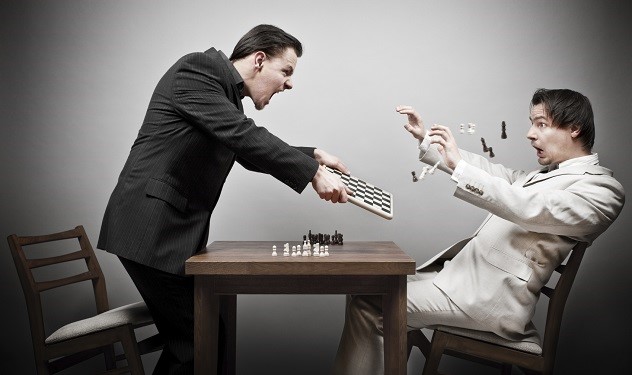
Bobby Fischer once said, “Chess is war over the board. The object is to crush the opponent’s mind.” And as for his greatest satisfaction, Fischer explained, “I like the moment when I break a man’s ego.” There are few things quite as humiliating as a chess loss. No wonder losers throughout history have flipped out and engaged in murderous violence.
Most anecdotes of sore losers involve royalty. Pepin the Short was said to have killed his opponent, Prince Okarius of Bavaria, by bludgeoning him with a rook. In AD 1027, Earl Ulf lost his temper and overturned the board when his opponent, King Canute, took back a move. Canute ordered the earl executed.
William the Conqueror clobbered a French prince with a chessboard after he was checkmated. A brawl between King Henry I of England and France’s Louis VI over chess in 1120 supposedly triggered a 12-year war.
Even further back, an Ummayad caliph named Al-Walid killed his courtier by throwing the firzan (a queen) at his head. What prompted this little outburst? Well, he found out that his courtier was deliberately losing their chess games, and this didn’t sit well with Al-Walid.
We may question the authenticity of such accounts, but there are too many stories to discount them all. Based on the evidence, it seems likely that some rulers reacted badly to defeat, or in Al-Walid’s case, victory. In those days, chess sets were made of stone and were surely tempting weapons in the hands of a frustrated player. Today, we are more sportsmanlike, and besides, chess sets are now made of wood or plastic. So we have relegated such violence to the medieval past, right?
Many modern players vent their anger by throwing tantrums, like Alekhine hurling pieces across the room or destroying furniture. But occasionally, games still end in blood and gore. The most extreme case was in Dublin in 2014 when Saverio Bellante stabbed his landlord, Tom O’Gorman, to death. Why? Well, Bellante grew incensed after O’Gorman called his king move “stupid and perverse.” Bellante then proceeded to cut open his victim and eat part of his heart. A jury eventually ruled Bellante not guilty by reason of insanity.
1 For The Love Of The Game

Chess addiction is a real thing. As H.G. Wells once put it, “The passion for playing chess is one of the most unaccountable in the world. [ . . . ] It is the most absorbing of occupations, the least satisfying of desires, an aimless excrescence upon life. It annihilates a man. [ . . . ] There is no remorse like the remorse of chess.”
Chess can make you ignore your job, your spouse, and even your own life. In AD 813, the succession struggle between the brothers Caliph Muhammad ibn Harun al-Amin and al-Ma’mun was reaching its climax as al-Ma’mun’s forces laid siege to the Abbasid capital of Baghdad. In an unparalleled bloodbath, al-Ma’mun advanced street by street to the Golden Gate Palace. Within its thick circular walls, Caliph al-Amin was engaged in a different kind of battle. Instead of fighting his brother, he was dueling his favorite eunuch, Kauthar, in a game of chess.
According to the medieval Islamic historian Jirjis al-Makin, a messenger burst in with news of the approaching enemy. “O Commander of the faithful,” implored the emissary, “this is not the time to play. Pray arise and attend to matters of more serious moment.” He might as well have been light-years away. Al-Amin was too engrossed at the game to pay attention to the messenger’s desperate entreaties for him to escape while there was yet time.
“Patience my friend,” the caliph calmly replied. “I see that in a few moves I shall give Kauthar checkmate.” A few moments later, al-Amin triumphantly trapped Kauthar’s king. But by then it was too late for al-Amin. The man who checkmated his eunuch was himself checkmated as his enemies swarmed the palace. Al-Amin was swiftly beheaded, and his brother Al-Ma’mun took over the Abbasid Empire.
H.G. Wells was right. Chess can annihilate a man.
Larry is a freelance writer whose main interests are history and chess. You can play a game with him at Chess.com.

